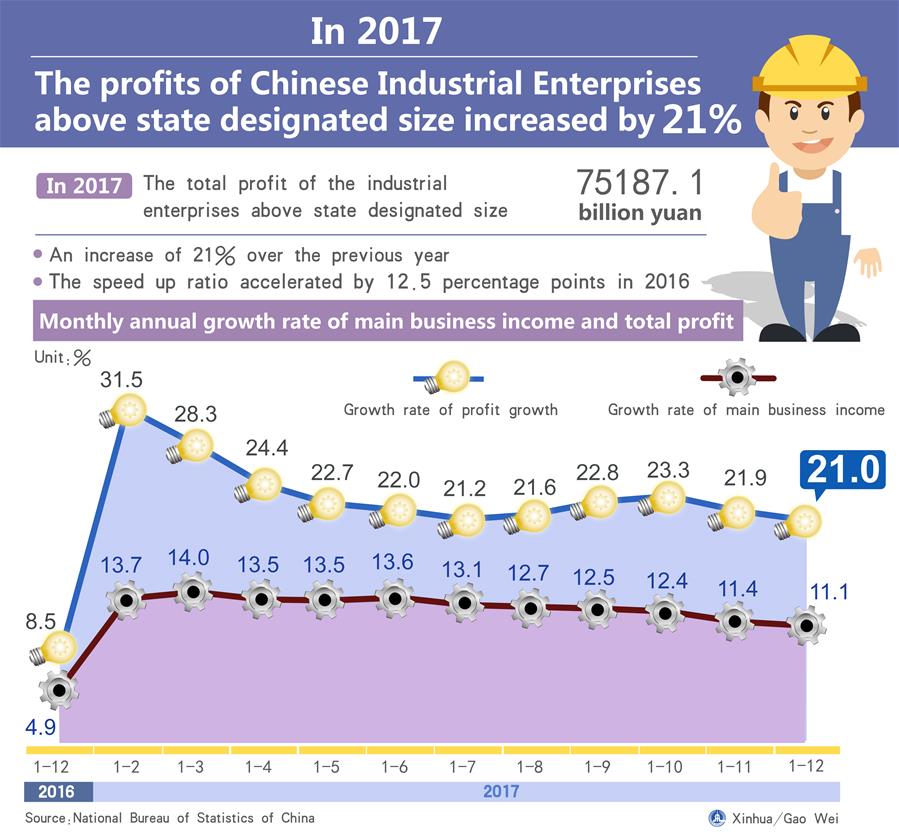
The graphics shows the profits of Chinese industrial enterprises above state designated size increased by 21% in 2017.(Xinhua/Gao Wei)
BEIJING, Jan. 26 (Xinhua) -- Profits at China's major industrial firms surged in 2017 on the back of the country's supply-side structural reform, the National Bureau of Statistics (NBS) said Friday.
Industrial companies with annual revenue over 20 million yuan (about 3 million U.S. dollars) reported total profits of more than 7.5 trillion yuan in 2017, up 21 percent from 2016, the NBS said in a statement.
The growth rate was slightly slower than the 21.9 percent in January-November, but was 12.5 percentage points faster than the 2016 reading, marking the strongest growth since 2012.
In December alone, the profits rose 10.8 percent year on year, down from 14.9-percent growth in November.
Combined revenue from main business totaled 116.5 trillion yuan, up 11.1 percent from 2016.
Industrial profit margins rose to 6.46 percent, up 0.54 percentage points year on year.
Among the 41 industries surveyed, 37 posted year-on-year profit growth in 2017, according to the NBS.
In 2017, profit in the mining sector more than tripled, reversing the 27.5-percent decline in 2016, and the manufacturing industry saw its profit up 18.2 percent in 2017, outpacing that in 2016 by 5.9 percentage points, the NBS data showed.
High-tech manufacturing enjoyed the fastest expansion among manufacturing sectors, with 20.3-percent profit growth in 2017, said NBS statistician He Ping.
He attributed the fast profit growth to ongoing supply-side structural reform.
"The manufacturing and business environment for enterprises has been improving, as the country has made headway in cutting industrial overcapacity and lowering corporate costs," He said.
The increase in steel and coal prices has driven up profits in the industries, as capacity reduction has improved quality, according to He.
Last year, China's state-owned enterprises eliminated 5.95 million tonnes of steel production capacity and 27.03 million tonnes of coal capacity, both exceeding the annual targets, official data showed.
Profits in coal mining and cleaning more than doubled in 2017, while those of ferrous metal and rolling processing nearly quadrupled, the NBS data showed.
The debt-asset ratio, which measures financial risk, declined amid deleveraging efforts, dropped to 55.8 percent by the end of November from 56.3 percent a year ago, thanks to government efforts to defuse financial risks.
The costs of major industrial firms continued to decline in 2017. For each 100 yuan of revenue, companies had to spend 84.92 yuan, down 0.25 yuan from last year, the NBS data showed.
Chinese businesses saved more than 1 trillion yuan from May 2016 to September 2017 as a result of the implementation of value-added tax, the most significant tax overhaul for two decades.
The tax reduction was only part of a bigger burden-relief plan for businesses, which will be a major task of supply-side structural reform in 2018.
The industrial sector, which accounts for about one-third of China's GDP, started to pick up in 2016 amid nationwide supply-side structural reform efforts.
China's economy expanded 6.9 percent in 2017, picking up for the first time in seven years and well above the government annual target of around 6.5 percent.
"The industrial sector is expected to further shift its focus toward high-quality development from high-speed expansion," He said.
Chinese Premier Li Keqiang said earlier this week that the country must continue to push reform and invigorate the economy to achieve high-quality development.
The transition to the new model was also stressed by senior official Liu He at the World Economic Forum in Switzerland on Wednesday.
Such a transition, he said, is the context in which China formulates its macroeconomic, structural, reform, and social policies in the coming years.















